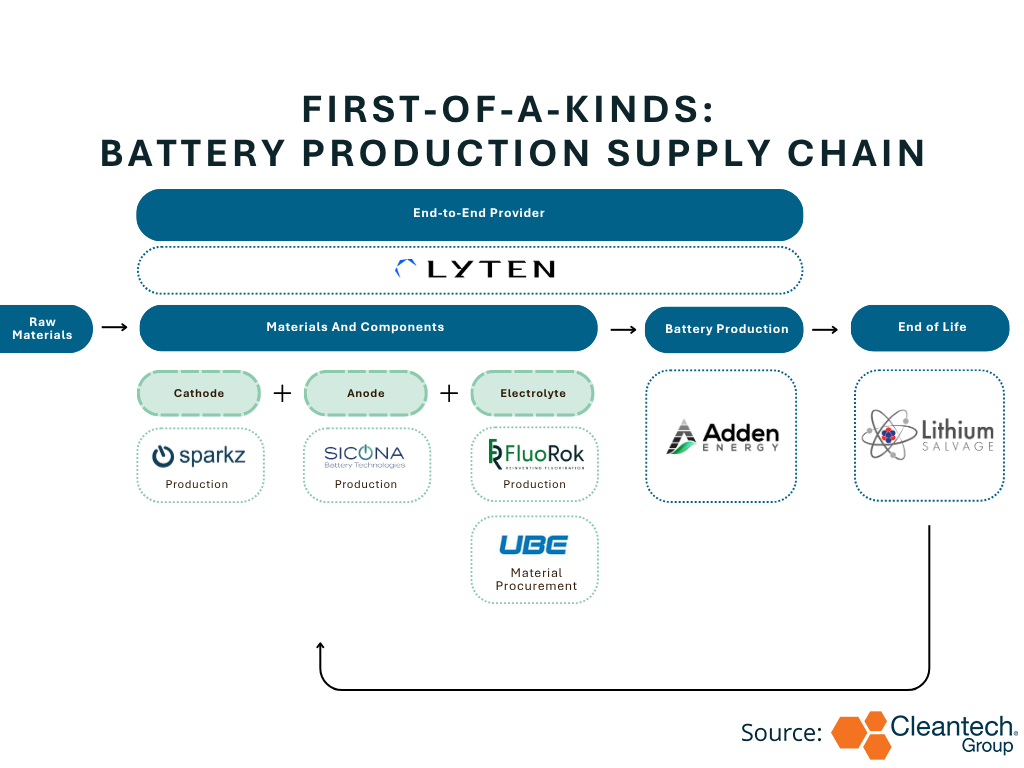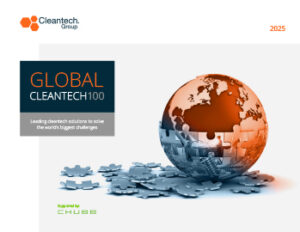First of a Kinds: A Year in Review
First-of-a-kind (FOAK) projects represent critical leverage for novel clean technologies to transition from prototypes to commercial solutions. If successful, FOAKs can de-risk innovation to unlock follow-on capital and regulatory support. Numerous FOAK projects have been catalyzed in the last year through targeted public-private partnerships. Many of these projects relied on blended funding packages to get them off the ground, reflecting an industrywide shift in approach to investing in large-scale cleantech development.
As we approach the halfway point of 2025, looking back at just some of these notable strides in innovation could shed light on the FOAK landscape to come.
The Supply Chain Showdown
U.S. innovators have been busy ramping up lithium-ion battery production, fuelled by Department of Energy (DOE) funding and corporate partnerships. Meanwhile, UK and Australian innovators advanced battery materials, manufacturing, and recycling.
- Sparkz secured a $9.8M DOE grant for its FOAK production facility for LFP battery materials. Partnering with the Mineworkers Union, the project supports ex-coal miners in the region and builds a domestic battery supply chain.
_ - Lyten and Dermody Properties signed an MOU to build the world’s first lithium-sulfur gigafactory in Reno, Nevada. It will produce cathode materials, lithium metal anodes, and up to 10GWh of batteries annually.
_ - UBE broke ground in February 2025 on the U.S.’s only DMC and EMC plant—critical inputs for lithium-ion batteries and semiconductors. It’s expected to be operational by 2026.
_ - Adden Energy commissioned a pilot line to manufacture large-scale lithium-ion batteries using dynamic stability for economic efficiency.
_ - FluoRok received funding from the UK’s Advanced Propulsion Centre and Department for Business and Trade to develop sustainable fluorination tech for domestic LiPF6 electrolyte salt—one of the first such UK-based pilot plants.
_ - Sicona Battery Technologies secured a commercial licensing deal for its SiCx silicon carbon anode, which boosts EV battery energy density by 20% and slashes charge time by 40%.
_ - Lithium Salvage raised $2.1M to develop a FOAK refinery for household lithium-ion battery waste at its Sunderland site.

The North Remembers
Canadian CCUS project developers scaled their technologies through strategic development partnerships and grant funding.
- Kruger and Mantel will launch an industrial demo at the Wayagamack Mill, using molten borate salt for boiler-integrated CO₂ capture. A $23.75M grant from Natural Resources Canada supports the 2-year test phase starting fall 2025.
_ - Carbonco and Genesis Fertilizers are developing Canada’s first low-carbon urea fertilizer plant, capturing 800,000 tons of CO₂ annually with operations slated for 2029.
_ - Svante received $100M from the Canadian Growth Fund to support FOAK carbon capture and removal projects in North America.
_ - 8 Rivers secured funding from JX Nippon for Project Cardinal, the first commercial deployment of Calcite direct air capture technology.
_ - Varme was granted $2.8M through Canada’s Tier program to scale the nation’s first industrial waste-to-energy facility, with Babcock & Wilcox designing the carbon capture tech.
_ - Heidelberg Materials progresses on the Mitchell Cement Plant’s full-scale carbon capture facility, supported by $300K of a broader $500M DOE package announced in March 2024.
Powering Up
Hybrid funding packages catalzyed energy storage FOAKs industrializing thermal storage, BESS and grid management.
- Rondo received grant and venture debt funding for three projects harnessing wind and solar energy.
_ - Highview Power raised $380M to build the UK’s first Liquid Air Energy Storage (LAES) facility in Manchester, with capacity to power 300,000 homes.
_ - Alterno raised $1.5M to scale its FOAK battery systems up to 1.8 megawatts for industrial use.
_ - Catalyze launched New York’s first megawatt-scale BESS in the Bronx, backed by $100M from NY Green Bank.
_ - Gridware, backed by $26.8M from Sequoia Capital, is deploying real-time FOAK grid-monitoring tech for faster response and more efficient grid operations.
_ - Form Energy received a $147M DOE grant to build the world’s largest long-duration, multi-day energy storage system in Lincoln, New England.
Something in the Water
Ocean-based FOAKs peppered the landscape in the last year, from algae-based remediation, innovative subsea monitoring and the world’s first maritime civil nuclear program.
- North Sea Farm 1, the world’s first commercial-scale algae farm off the Dutch coast, began operations last year. It received a $1.67M grant from Amazon’s Right Now Climate Fund to explore carbon capture benefits.
_ - CH4 Global secured investment from Chipotle to scale its seaweed-based methane-reduction solution. It’s building the world’s first commercial asparagopsis production facility.
_ - Ocean Infinity completed a subsea survey for an Ørsted and PGE wind project in the Baltic Sea using FOAK real-time remote ocean monitoring technology.
_ - Core-Power, with Mitsubishi Research, is progressing the world’s first maritime civil nuclear initiative—including a molten-salt reactor ship and floating nuclear plant, which will be supported by its ongoing Series B once it closes.
More Passion, More Energy
Speaking of nuclear, several innovative fusion projects saw traction in the last year as more governments seek new ways to sustainably meet growing energy demand. Projects revolutionizing hydrogen production and energy efficient computing also gained ground in the last year.
- VulcanX is building a hydrogen methane pyrolysis plant in British Columbia in partnership with Fortis BC.
_ - Lightsolver, backed by $13.6M from the European Innovation Council, is developing the first all-optical supercomputer to tackle energy-intensive computing.
_ - Niko raised $23M to develop Mexico’s first virtual power plant, combining solar and battery storage.
_ - Power to Hydrogen (P2H2) raised $18M in Series A funding to build the world’s first industrial-scale AEM electrolysis system for hydrogen.
_ - Nel Hydrogen, Topsoe, Skovgaard Energy, and Vestas opened the world’s first dynamic, renewable-powered green ammonia plant in Ramme, Denmark—no batteries required.
_ - Commonwealth Fusion and Dominion Energy partnered to develop the world’s first commercial fusion power plant in Chesterfield. The 400MW facility is expected to start up in the early 2030s.
What Can We Expect?
The cleantech FOAK ecosystem has become more resilient with developers leveraging multiple different paths to deployment. These projects could lay important groundwork for enabling policy and validate market readiness for pioneering technologies. With franken-funding more readily available, innovators and the not-so-mad scientists behind pioneering technologies face a better chance of conquering the funding ‘valley of death’ that stands between development and commercialization.



